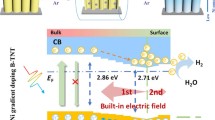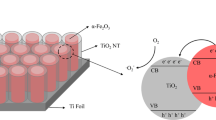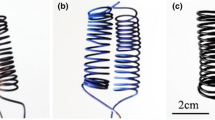Abstract
Highly ordered TiO2 nanotube film on a titanium foil was prepared by an anodization process. Then, the anatase–rutile hybrid crystal TiO2 materials fabricated at 700 °C were used as an anode for electrochemical synthesis of benzoic acid from toluene. At this anode, the highest yield of benzoic acid at ambient temperature is 27.5%, but it rises to 32.8% at 90 °C with a toluene conversion rate of 49.1%. The yield is increased mainly due to the hybrid crystal of the novel anode, and the formation of carbonized TiO2 nanotube surface at the Ti substrate together facilitates the charge transfer and induces a significant enhancement in the anode reactivity. Moreover, the effects of calcination temperature on the morphology, structures and crystallization of the TiO2 nanotubes were discussed in detail. A synergistic effect of electric field, visible light irradiation, and temperature for benzoic acid synthesis at the anatase–rutile hybrid crystal TiO2 was discussed. To our knowledge, this is the first study about the use of the carbonized anatase–rutile hybrid TiO2 nanotube films electrode in benzoic acid synthesis under the coupling fields. This study provides new insights into high-performance metal oxide electrode materials for organic synthesis.







Similar content being viewed by others
References
Vincenzo B (2005) Nanoscience and nanotechnology: a personal view of a chemist. Small 1:278–283
George MW (2005) Nanoscience, nanotechnology, and chemistry. Small 1:172–179
Wang Z, Wu W (2012) Nanotechnology-enabled energy harvesting for self-powered micro-/nanosystems. Angew Chem Int Ed 51:11700–11721
Chen X, Mao SS (2007) Titanium dioxide nanomaterials: synthesis, properties, modifications, and applications. Chem Rev 107:2891–2959
Somaieh M, Adam H, Kamelia VKB (2014) Synthesis of TiO2 nanoparticles in a spinning disc reactor. Chem Eng J 258:171–184
Zhu YJ, Wang HY, Wang BH et al (2016) Solar thermoelectric field plus photocatalysis for efficient organic synthesis exemplified by toluene to benzoic acid. Appl Catal B Environ 193:151–159
Roy P, Berger S, Schmuki P (2011) TiO2 nanotubes: synthesis and applications. Angew Chem Int Ed 50:2904–2939
Xiong H, Slater MD, Balasubramanian M et al (2011) Amorphous TiO2 nanotube anode for rechargeable sodium ion batteries. J Phys Chem Lett 2:2560–2565
Regonini D, Bowen CR, Jaroenworaluck A et al (2013) A review of growth mechanism, structure and crystallinity of anodized TiO2 nanotubes. Mater Sci Eng, R 74:377–406
Zhang Q, Cao G (2011) Nanostructured photoelectrodes for dye-sensitized solar cells. Nano Today 6:91–109
Meng CH, Liu ZY, Zhang TR et al (2015) Layered MoS2 nanoparticles on TiO2 nanotubes by a photocatalytic strategy for use as high-performance electrocatalysts in hydrogen evolution reactions. Green Chem 17:2764–2768
Damien D, Ilias B, Khalil A (2010) Tailored preparation methods of TiO2 anatase, rutile, brookite: mechanism of formation and electrochemical properties. Chem Mater 22:1173–1179
Scanlon DO, Dunnill CW, Buckeridge J et al (2013) Band alignment of rutile and anatase TiO2. Nat Mater 12:798–801
Crossland EJW, Noel N, Sivaram V et al (2013) Mesoporous TiO2 single crystals delivering enhanced mobility and optoelectronic device performance. Nature 495:215–219
Kim HS, Lee JW, Yantara N et al (2013) High efficiency solid-state sensitized solar cell-based on submicrometer rutile TiO2 nanorod and CH3NH3PbI3 perovskite sensitizer. Nano Lett 13:2412–2417
Hanaor DAH, Sorrell CC (2011) Review of the anatase to rutile phase transformation. J Mater Sci 46:855–874. doi:10.1007/s10853-010-5113-0
Wang GM, Wang HY, Ling YL et al (2011) Hydrogen-treated TiO2 nanowire arrays for photoelectrochemical water splitting. Nano Lett 11:3026–3033
Kho YK, Iwase A, Teoh WY et al (2010) Photocatalytic H2 evolution over TiO2 nanoparticles. The synergistic effect of anatase and rutile. J Phys Chem C 114:2821–2829
Yu J, Dai G, Cheng B (2010) Effect of crystallization methods on morphology and photocatalytic activity of anodized TiO2 nanotube array films. J Phys Chem C 114:19378–19385
Zhu YJ, Wang BH, Liu XL et al (2014) STEP organic synthesis: an efficient solar, electrochemical process for the synthesis of benzoic acid. Green Chem 16:4758–4766
Zhu YJ, Wang BH, Wang HY et al (2015) Towards efficient solar STEP synthesis of benzoic acid: role of graphite electrode. Sol Energy 113:303–312
Bojinova A, Kralchevska R, Poulios I et al (2007) Anatase/rutile TiO2 composites: influence of the mixing ratio on the photocatalytic degradation of malachite green and orange II in slurry. Mater Chem Phys 106(2):187–192
Bakardjieva S, Šubrt J, Štengl V et al (2005) Photoactivity of anatase–rutile TiO2 nanocrystalline mixtures obtained by heat treatment of homogeneously precipitated anatase. Appl Catal B Environ 58(3):193–202
Mirabolghasemi H, Liu N, Lee K et al (2013) Formation of ‘single walled’ TiO2 nanotubes with significantly enhanced electronic properties for higher efficiency dye-sensitized solar cells. Chem Commun 49:2067–2069
Lv J, Shen Y, Peng L et al (2010) Exclusively selective oxidation of toluene to benzaldehyde on ceria nanocubes by molecular oxygen. Chem Commun 46:5909–5911
Kesavan L, Tiruvalam R, Rahim Ab et al (2011) Solvent-free oxidation of primary carbon-hydrogen bonds in toluene using Au–Pd alloy nanoparticles. Science 331:195–199
Titirici MM, White RJ, Brun N et al (2015) Sustainable carbon materials. Chem Soc Rev 44:250–290
Hurum DC, Agrios AG, Gray KA et al (2003) Explaining the enhanced photocatalytic activity of degussa P25 mixed-phase TiO2 using EPR. J Phys Chem B 107:4545–4549
Yang HG, Sun CH, Qiao SZ et al (2008) Crystal growth: anatase shows its reactive side. Nature 453:638–641
Hahn R, Schmidt-Stein F, Salonen J et al (2009) Semimetallic TiO2 Nanotubes. Angew Chem 121:7372–7375
Serpone N (2006) Is the band gap of pristine TiO2 narrowed by anion-and cation-doping of titanium dioxide in second-generation photocatalysts? J Phys Chem B 110:24287–24293
Kiran V, Sampath S (2012) Enhanced Raman spectroscopy of molecules adsorbed on carbon-doped TiO2 obtained from titanium carbide: a visible-light-assisted renewable substrate. ACS Appl Mater Inter 4:3818–3828
Li G, Li J, Li G et al (2015) N and Ti3+ co-doped 3D anatase TiO2 superstructures composed of ultrathin nanosheets with enhanced visible light photocatalytic activity. J Mater Chem A 3(44):22073–22080
Ren W, Ai Z, Jia F et al (2007) Low temperature preparation and visible light photocatalytic activity of mesoporous carbon-doped crystalline TiO2. Appl Catal B Environ 69:138–144
Pang YL, Abdullah AZ (2013) Effect of carbon and nitrogen co-doping on characteristics and sonocatalytic activity of TiO2 nanotubes catalyst for degradation of Rhodamine B in water. Chem Eng J 214:129–138
Li S, Zhang G, Guo D et al (2009) Anodization fabrication of highly ordered TiO2 nanotubes. J Phys Chem C 113:12759–12765
Fang D, Luo ZP, Huang KL et al (2011) Effect of heat treatment on morphology, crystalline structure and photocatalysis properties of TiO2 nanotubes on Ti substrate and freestanding membrane. Appl Surf Sci 257(15):6451–6461
Nolan NT, Synnott DW, Seery MK et al (2012) Effect of N-doping on the photocatalytic activity of sol–gel TiO2. J Hazard Mater 211–212:88–94
Gouma PI, Mills MJ (2001) Anatase to rutile transformation in powders of titania. J Am Ceram Soc 84:619–622
Pawar SG, Patil SL, Chougule MA et al (2011) Synthesis and characterization of nanocrystalline TiO2 thin films. J Mater Sci: Mater Electron 22(3):260–264
Takahara Y, Kondo JN, Takata T et al (2001) Mesoporous Tantalum Oxide. 1. Characterization and photocatalytic activity for the overall water decomposition. Chem Mater 13:1194–1199
Kyaw AKK, Wang DH, Gupta V et al (2013) Intensity dependence of current–voltage characteristics and recombination in high-efficiency solution-processed small-molecule solar cells. ACS Nano 7:4569–4577
Ma Y, Wang XL, Jia YS et al (2014) Titanium dioxide-based nanomaterials for photocatalytic fuel generations. Chem Rev 114:9987–10043
Hou Y, Li XY, Zhao QD et al (2012) Role of hydroxyl radicals and mechanism of Escherichia coli inactivation on Ag/AgBr/TiO2 nanotube array electrode under visible light irradiation. Environ Sci Technol 46(7):4042–4050
Jiang Z, Wang H, Huang H et al (2004) Photocatalysis enhancement by electric field: TiO2 thin film for degradation of dye X-3B. Chemosphere 56:503–508
Tripathy J, Lee K, Schmuki P (2014) Tuning the selectivity of photocatalytic synthetic reactions using modified TiO2 nanotubes. Angew Chem 126(46):12813–12816
Acknowledgements
The research was financially supported by the National Young Top Talents Plan of China (2013042), National Science Foundation of China (Grant Nos. 21676052, 21606042), Science Foundation for Distinguished Young Scholars (JC201403) and Natural Science Foundation of Heilongjiang Province (E2015034), the State Key Laboratory of Materials-Oriented Chemical Engineering (KL15-11) and the China Postdoctoral Science Foundation Funded Project (2016M600406).
Author information
Authors and Affiliations
Corresponding author
Electronic supplementary material
Below is the link to the electronic supplementary material.
Rights and permissions
About this article
Cite this article
Zhu, Y., Li, H., Gu, D. et al. Honeycomb hybrid crystal TiO2 film electrode for efficient benzoic acid synthesis. J Mater Sci 52, 6623–6634 (2017). https://doi.org/10.1007/s10853-017-0898-8
Received:
Accepted:
Published:
Issue Date:
DOI: https://doi.org/10.1007/s10853-017-0898-8




